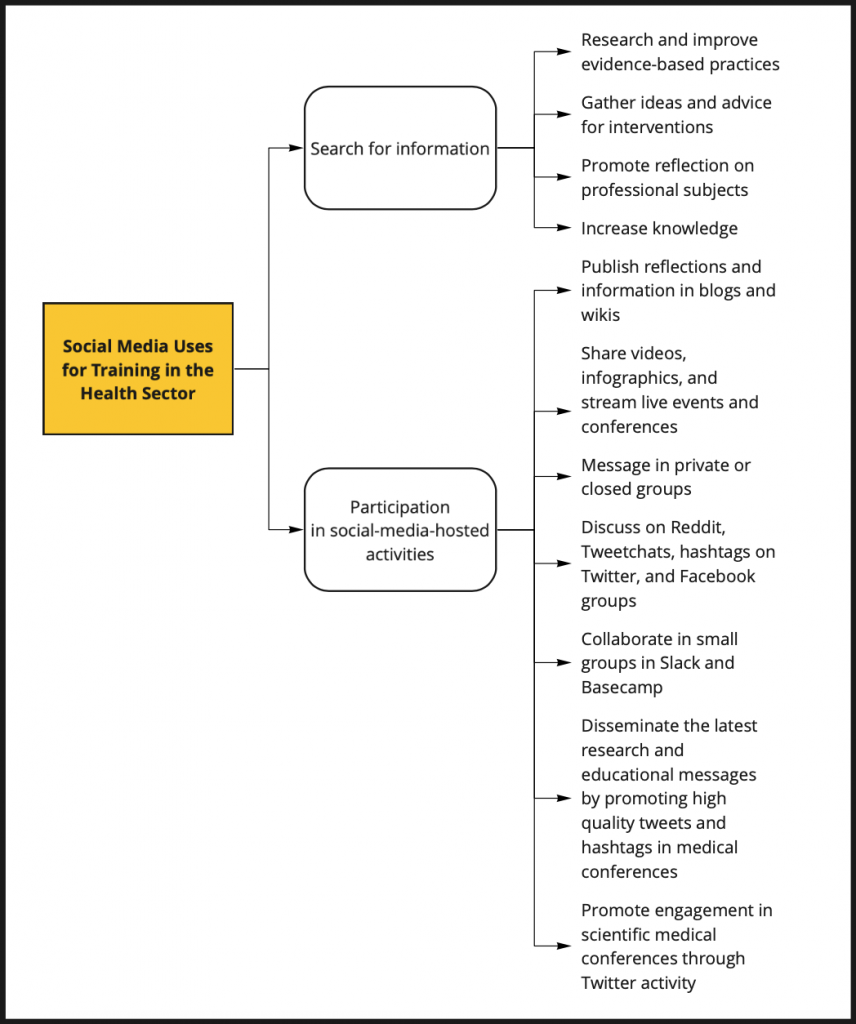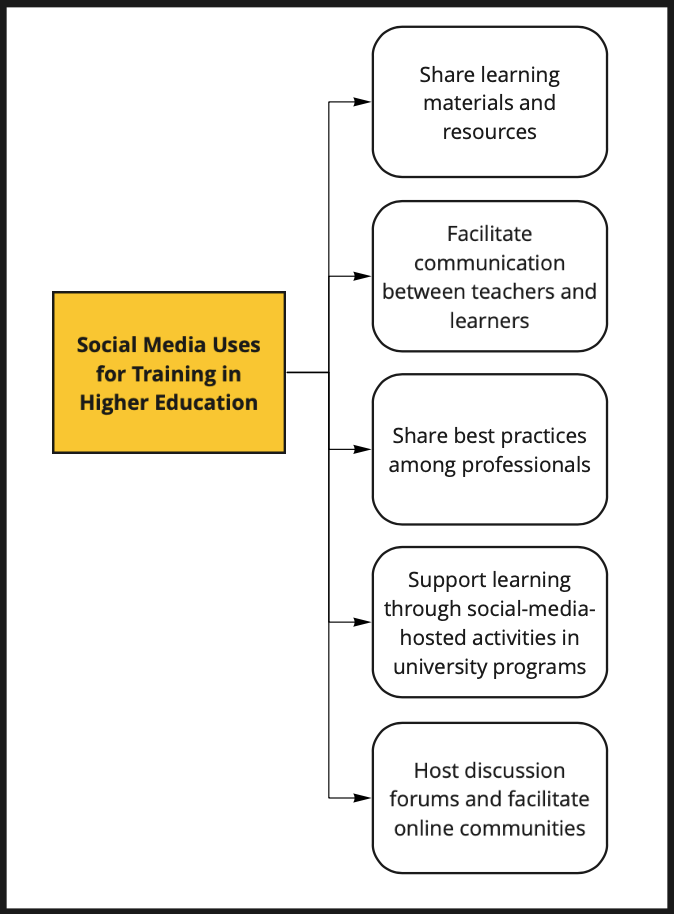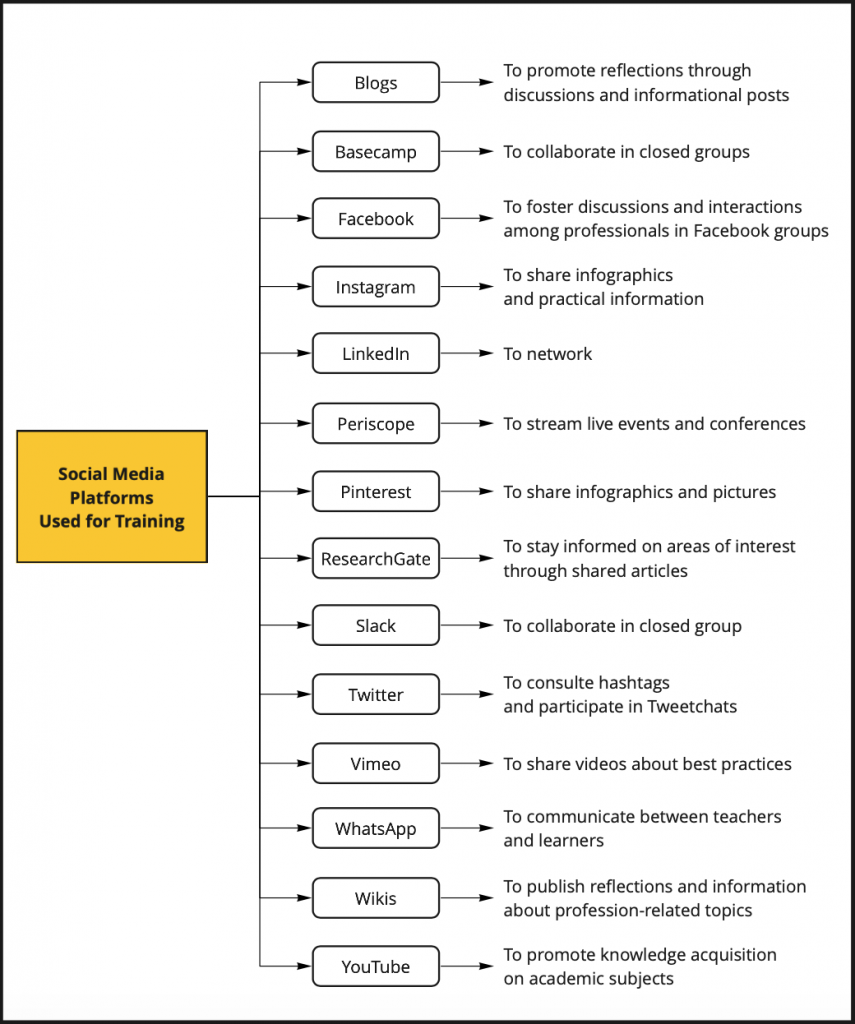Using social media for training: An overview of 2019
This literature review synthesizes the current uses of social media for training as discussed in a selection of peer-reviewed articles, conceptual papers, and reviews of literature published in 2019.
Our findings indicate that the main use of social media is for Continuing Professional Development (CPD) purposes. In the health sector, for example, the use of social media supports the learning and development of occupational therapists (OT) and occupational therapy students, promotes engagement in scientific medical conferences, and supports nurses’ revalidation and professional development activities.
In Higher Education, educators use social media to (a) share learning materials; (b) to communicate with students; (c) to share best-practices among professionals, (d) to support learning through social media-based activities, and (e) to host discussion forums and online communities.
Methodology
We performed a Boolean/Phrase type of search in late October 2019 in EBSCO Host listed databases Academic Search Premier, Education Source, ERIC, and Human Resources Abstracts.
Out of 1572 initially identified publications discussing emergent technologies for training purposes, 12 articles on social media were selected for final synthesis according to the following explicit inclusion criteria:
- The articles reported the use of social media within the scope of training in higher education, health, banking, human resources, transportation, government, and private organizations.
- The full text was available (If a paper was unavailable via database searches, requests were sent directly to the authors).
- The articles were in English.
- The articles had been published in 2019.
The literature review aimed to answer two questions:
- RQ1. What social media applications and platforms are used for training purposes in higher education, health, banking, human resources, transportation, government, and private organizations?
- RQ2. How are these social media platforms, applications or features used?
The selected papers report studies conducted in the United Kingdom, Canada, New Zealand, Malaysia, Saudi Arabia, Ireland, United Arab Emirates, India, Japan, the United States of America, and Spain.
From the 12 articles we selected, social media uses for training were only identified in 2 of the 7 sectors we targeted. Three articles addressed the health context (Jaremko et al., 2019; Moorley & Chinn, 2019; Murray & Ward, 2019) and 9 addressed the higher education context (Abrahim et al., 2019; Anderson, 2019; Darwish, 2019; Goodyear et al., 2019; Kumar & Nanda, 2019; Murugaiah & Yen, 2019; Narayan et al., 2019; Santoveña-Casal, 2019; Sharma, 2019).
Results
Social media use for training in the health sector
Social media is used to support the learning and development of health professionals and students. It is considered a tool for Continuing Professional Development (CPD) of occupational therapy students and qualified occupational therapists (Murray & Ward, 2019); for participatory CPD of nurses (Moorley & Chinn, 2019), and for medical education (Jaremko et al 2019). Health professionals and students are the main actors involved in social media activity with training purposes. They search for information on different social media sites and participate in social media-hosted activities and online communities.
Searching for information on social media sites
Occupational therapy (OT) students and occupational therapists use social media to support their knowledge development. They use Twitter to network, to follow conferences and “study days” in different areas of practice, to gather different ideas for practice through hashtags such as #Otalk, and to stay up-to-date on policy and research. They use blogs as interactive public spaces that enable deeper reflection on different subjects related to their field, Pinterest to look for ideas for OT interventions, Facebook to ask questions and advice from other practitioners, and Research Gate to stay up-to-date on areas of interest (Murray & Ward, 2019).

Participating in social media-hosted activities
To participate in social media-hosted activities like Tweetchats, occupational therapy (OT) students and occupational therapists not only share information, they create and share content. They publish reflections and information in blogs and wikis (Moorley & Chinn, 2019), share videos on Vimeo, and YouTube, post infographics on Pinterest and Instagram, stream live events and conferences on Periscope (Moorley & Chinn, 2019), and share knowledge in 4OT groups and private groups on Facebook (Murray & Ward, 2019).
They send private messages to closed group discussions on WhatsApp and Facebook messenger (Moorley & Chinn, 2019), and discuss news, information, experiences, resources, research, and evidence on Reddit, Tweetchats and hashtags on Twitter, and Facebook groups (Moorley & Chinn, 2019).
Occupational therapy (OT) students and occupational therapists collaborate in closed groups on Slack and Basecamp (Moorley & Chinn, 2019), network on LinkedIn and explore its blogging function and slide sharing functionalities (Moorley & Chinn, 2019), promote engagement in scientific medical conferences through Twitter activity (Jaremko et al., 2019), and disseminate the latest research and educational messages through high-quality tweets in medical conferences hashtags (Jaremko et al., 2019).
Moorley and Chinn (2019) explain that revalidation, required for nurses in the UK to renew their registration, has been a catalyst in nurses using social media for professional and educational purposes. In their study, inductive thematic analysis was performed on the data collected after the @WeNurses twitter group using the hashtag #WeNurses, the Experiences of Care Week and the WeLearn Project. The authors found that social media was used for publishing reflections and information, sharing videos and infographics, streaming live events and conferences, messaging in private or closed group discussions, discussing news, information, experiences, resources, research, and evidence, collaborating in closed groups, as well as networking. They conclude that organized social media events such as blogs, tweetchats, Twitter storms, webinars, infographics, podcasts, videos, and virtual book clubs can support the professional development of nurses.
Jaremko et al. (2019) report on a deliberate social media strategy to promote Twitter activity and engagement for an annual pain medicine conference. The authors compared the Twitter activity of the annual fall pain medicine conference hosted by the American Society of Regional Anesthesia and Pain Medicine (ASRA) 2015 edition with the one of the 2016 edition. For the 2016 edition of the conference, the organizers deployed a series of strategies seeking to promote a high-quality Twitter activity among the conference attendees. These strategies include: (a) registering the conference hashtag with a learning analytics enterprise to analyze the results, (b) advertising the conference hashtag in all promotional materials and tweets related to the conference, (c) emphasizing the quality and not the number of tweets, (d) giving credit to the speakers and including them in tweets about their presentations, and (e) keeping tweets clean and professional. As a result, the quality of tweets associated with the hashtag significantly increased. Most of the tweets were scientific in nature, included links, references or some form of media like images, and nearly all tweets were original and not replies or modified retweets.
Jaremko et al. (2019) found that a focused integration strategy of Twitter in scientific conferences may lead to an improvement in the quantity and quality of live tweets and attendee engagement, which in turn, promotes the latest research and key educational messages from delegates in scientific conferences. The authors propose four categories of Twitter metrics for the purposes of reporting Twitter usage in medical education: (a) growth, which refers to the number of tweets and participants, (b) reach, which refers to impressions and followers, (c) content quality, which refers to the usefulness of media and retweets, and (d) engagement, which refers to the number of mentions and replies.
Social media use for training in higher education

Students, professors, and educational professionals use social in higher education to share learning materials, facilitate the communication between the students and their professors, share best-practices among professionals, support learning through social media-based activities, and host discussion forums and online communities.
Facebook facilitates the virtual sharing of educational resources, pedagogical material, ideas, career interests and related information (Abrahim et al., 2019, Murugaiah & Yen, 2019). WhatsApp is used as a platform for participation where students post answers to their teachers’ questions (Murugaiah & Yen, 2019).
Goodyear et al. (2019) studied a Twitter-based professional learning community of teachers. The authors were interested in understanding how teacher learning occurs via social media and how social media foster professional development. They analyzed the interactions of a Twitter-based chat forum that uses the hashtag (#pechat) and the data they collected from interviews they conducted with 18 participants.
The authors identified engagement and shared practices as the two themes representing the nature of the Twitter-based professional learning community.
Regarding engagement, two predominant forms were identified: active engagement, which was associated with participants who held a ‘big name on Twitter’ identity, and observational engagement, which was associated with participants who were described as ‘lurkers’. The ‘big names on Twitter’ shared dominant views, presented high levels of interactivity, and were described as being white males with a certain privilege for their voice to be heard. Lurkers’ activity involved observing tweets and rarely commenting. Rather than sharing opinions, their tweets often involved asking questions. The findings suggest that the nature of the learning was shaped by positions of power and influence.
Shared practices refer to “how participants generated new understandings, new ideas, and new practices that could be transferred into their lessons” (Goodyear et al., 2019, p. 429). Most discussions on Twitter involved sharing practices around pre-defined topics, which was perceived as useful by practitioners who were able to apply new ideas in their classes. Social media can help teachers overcome some of the barriers they perceive when it comes to engaging in professional development activities (Goodyear et al., 2019).
Narayan et al. (2019) propose a learning solution that embeds the use of mobile and social media tools in a journalism course underpinned by heutagogical principles. Heutagogy, also known as self-determined learning is a student-centered educational strategy that focuses on the development of autonomy, capacity, and capability (Blaschke, 2012) and is the learning theory that supports the authors’ proposal. The authors argue that social media tools can be harnessed to facilitate a student-determined learning experience. They provide design principles elicited from a 2-year study where social media tools were used by undergraduates in journalism programs to create, report, and engage with the audience. Students created a personal blog using WordPress and a Twitter account. As part of the learning process, the students were required to create and include multimedia content in their reflective blog posts and the final news story assignments using tools of their choice such as YouTube Capture, Piktochart, Hyperlapse, SoundCloud, Google Maps, and Vine. Basically, students used their mobile devices and social media apps to capture contextual data and information to advance their learning and write a news story.
Santoveña-Casal (2019) conducted a mixed-method study to analyze the influence of social media participation on the academic performance of an undergraduate class and a postgraduate class. Students had to choose between a traditional activity or a Twitter activity that accounted for 20% or 30% of the course grade. Out of 1960 students taking the courses, 411 took part in the Twitter continuous assessment activity. Data on academic performance was obtained from students’ marks on examinations, Twitter activity, and global course evaluation. Findings indicate that students who completed the twitter activity earned higher grades than the students who completed the traditional activity, yet, Twitter participation had no significant influence on academic performance. The author believes that the proposed Twitter activity lacked relevance since it was meant for students to learn to interact on Twitter and form a community instead of supporting deeper educational objectives. Santoveña-Casal (2019) recommends considering three stages of instruction (i.e., beginners, intermediate, and professional) when designing a course based on social media participation to offer scaffolding according to educational level or social media competency.
Kumar & Nanda (2019) indicate that social media can lead to improvements in the way higher education institutions can assist with student engagement and development. The authors propose a framework for social media engagement in higher education that considers the most important processes in higher education institutions, which are (1) promotion and admissions; (2) on-campus engagement, (3) alumni and networking, and (4) placement and career development. For campus engagement, discussion forums and sharing of materials are the two most important activities. The authors consider that Learning Management Systems (LMS) can play an important role in material sharing while WhatsApp, Facebook, and Twitter can be used to create discussion forums and online communities. They believe that YouTube, Facebook, Instagram, and Pinterest can serve as the most important social media platforms during the promotion and admissions process since future students can participate in the FAQ chats using Facebook, watch photos and videos showing the campus infrastructure (360 campus tours) and activities in YouTube, Pinterest, and Instagram. LinkedIn, Facebook, Twitter, and blogs could favor mentoring, career guidance and fundraising, which are more related to alumni and networking processes. The same social media platforms are useful for professional profiling and job hunting when it comes to the placement and career development processes.
Social media platforms used for training

As discussed earlier, social media is used as a tool for Continuing Professional Development of professional groups such as occupational therapists, teachers, nurses, and medical education. This practice is initiated by the learners themselves. In fact, individual professionals, professionals in learning communities or conference organizers are the main agents involved in social media activities with training and learning purposes. They play an active role in social media interactions through searching for information on different social media sites and platforms and/or through participating in social media-hosted activities and online communities.
While organized social media events such tweetchats, Twitter storms, and Twitter hashtags, as well as blogs, webinars, infographics, podcasts, and videos, have the potential to support training and professional development when on social media, professionals take control of their continuing professional development. They search for information, share best practices, interact with the members of their professional online communities, and discuss current topics related to their profession on a variety of social media platforms such as Twitter, Periscope, and Facebook.
Twitter was the social media application used the most for training. In particular, hashtags and organized discussions called Tweetchats were reported to be used for learning and training. Facebook was the second most used social media application. Facebook groups were reported as fostering discussions and interactions among professionals in a type of community of practice dynamics. Blogs such as WordPress were mentioned as sites promoting reflections through discussions and informational posts. Pinterest was reported to be useful for sharing infographics while YouTube videos were used to promote knowledge acquisition on academic subjects. LinkedIn was the networking site by excellence while Instagram was used for sharing infographics and practice information.
